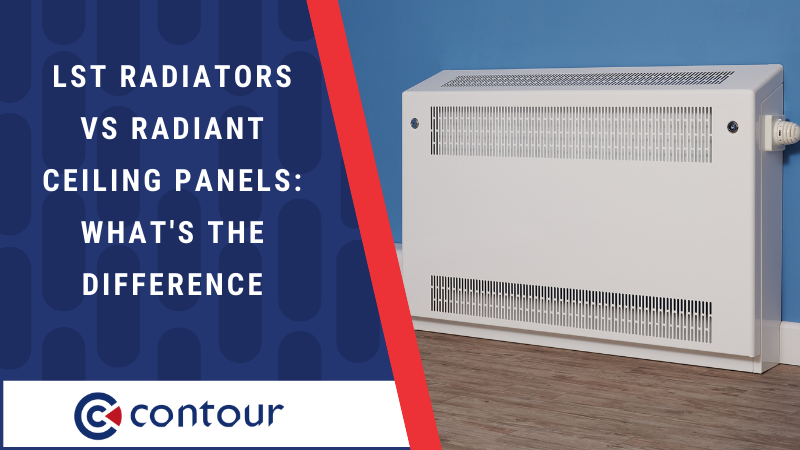
Contour: What Is The Difference Between LST Radiators & Radiant Ceiling Panels?
Whether you’re specifying heating options for an entirely new development, or looking for options as part of a refurbishment, selecting the correct heating products is critical, as Contour explains…
Whether it’s a hospital project, a care home, or an educational environment, there’s a lot to think about.
You need to make sure that regulations and guidelines are being met, that the heating solution is well suited to the environment, that it is safe for those in the surrounding environment as well as considering a whole range of other things.
This piece explores how low surface temperature radiators can be used in these environments, whilst comparing them with radiant ceiling panels to determine where you should use each and on what project.

What is an LST Radiator?
A LST or low surface temperature radiator is a heating product that doesn’t exceed a surface temperature of 43oC. This means that it is fully concealed and safe to touch, ideal for environments such as schools, hospitals and care homes where potentially vulnerable people could easily come to harm.
A safer alternative to traditional radiators, low surface temperature radiators are a common heating option when specifying in the public sector, and often include unique design features that make regular cleaning and maintenance far easier.
Advantages of Low Surface Temperature Radiators
Depending on the type of project, LST radiators make for an obvious choice if you are working on a refurbishment project where you are upgrading the existing heating system. This is due to pipework routes already being in place or if they need to be added to, this is an easy task to carry out.
Because they are readily available, LST radiators often make for a much more obvious heating solution.
Like radiators in general, they are quick to come up to temperature and react fast to changes in desired temperature.
Disadvantages of Low Surface Temperature Radiators
Although they seem like an obvious choice, there are some projects where low surface temperature radiators would not be an ideal fit.
For instance, in places where some corridors might be particularly narrow, installing an LST radiator would significantly reduce wall space.
Depending on certain models, they can also be a breeding ground for dirt and dust. That’s why Contour’s range are designed with cleanliness and hygiene in mind, allowing cleaning teams to remove any dust, quickly and efficiently.
Using a unique pivoting device called Rotarad, radiators can be dropped down towards the floor in order to clean behind them. This means that not only do Contour covers help aid in the cleaning, but the radiators themselves can be adapted too.
It’s important that prior to any installation that a full survey is conducted by a heating professional who will guide you on the best possible solutions.
What is a Radiant Ceiling Panel?
As the name would suggest, these panels radiate heat from the ceiling and warm up solid objects in the surrounding area. Similar to traditional radiators, radiant ceiling panels can be heated using water, while there are also electric versions which generate heat waves through electrical resistance radiant ceiling panels radiate heat, warming up solid objects in a single area.
Unlike traditional radiators which rely on heated water systems, radiant ceiling panels use electricity to produce a gentle type of infrared energy.
Advantages of Radiant Ceiling Panels
One of the key advantages of ceiling panels is very similar to the advantages of using underfloor heating. It has an incredibly sleek design and frees up space to manoeuvre around tight corridors and rooms.
Then, with this freedom of space, environments can become much more hygienic and are easily maintained.
Disadvantages of Radiant Ceiling Panels
Unfortunately, they’re not without their downfalls either. Radiant panels can be difficult for some mental health service users to distinguish, causing unwanted panic. Dementia patients can be confused by the fact there isn’t a radiator in the room giving off heat.
They can also be quite overwhelming for vulnerable people as the heat is a constant bearing from above, often making them feel quite sick.
Depending on the type of project, radiant ceiling panels may not be a viable option depending on the ceiling in each room.
Conclusion
Ultimately, when it comes to selecting LST radiators or radiant ceiling panels it depends on the type of project you are specifying for.
Is the infrastructure in place? What are the size of the rooms? Is it a new project or a retrofit? Everything has to be considered before you can make a concrete decision on the best heating options for you.
The most important thing is, there are options available and Contour are on hand to guide you.
To read Contour’s piece on the difference between LST radiators and underfloor heating, click here.
Contour can be contacted at;
The Mansions
43 Broadway
Shifnal
TF11 8BB
Tel: 01952 290 498
Email: sales@contourheating.co.uk
Visit Supplier's page
Latest news

11th April 2025
Don’t Do a Dave! It’s Time to Lock FIT Show 2025 in Your Calendar!
It’s that time again – FIT Show is back! You could be forgiven for thinking there won’t be much new to see when FIT Show returns to the NEC from 29 April – 1 May. Wrong!
Posted in Articles, Building Industry Events, Building Industry News, Building Products & Structures, Building Services, Continuing Professional Development (CPD's), Exhibitions and Conferences, Information Technology, Innovations & New Products, Restoration & Refurbishment, Retrofit & Renovation, Seminars, Training
11th April 2025
Insight Data: Boost construction success with project and prospect data
For those working in construction – in whatever capacity – the last few years haven’t been much fun. And according to the latest statistics, it would seem the challenges are continuing – Alex Tremlett, Insight Data’s Commercial Director, has more…
Posted in Articles, Building Industry News, Building Services, Information Technology, news, Research & Materials Testing
11th April 2025
ASSA ABLOY EMEIA: Learn how to tackle the security challenges of digitalising access with insights from industry experts
In a new series of videos, experts in various specialisms within ASSA ABLOY share their expertise on digital access, including the complexities to overcome and the range of benefits for those who get digital access right…
Posted in Access Control & Door Entry Systems, Architectural Ironmongery, Articles, Building Industry News, Building Products & Structures, Building Services, Doors, Facility Management & Building Services, Information Technology, Innovations & New Products, Posts, Restoration & Refurbishment, Retrofit & Renovation, Security and Fire Protection, Videos
10th April 2025
Geberit completes 150 Acts of Kindness
Geberit has raised nearly £14,000 for various charities through its ‘150 Acts of Kindness’ initiative, a year-long programme of fundraising and volunteering to mark the company’s 150th anniversary in 2024.
Posted in Articles, Bathrooms & Toilets, Bathrooms, Bedrooms & Washrooms, Building Industry Events, Building Industry News, Building Products & Structures, Building Services, Charity work, Drainage, Interiors, Pipes, Pipes & Fittings, Plumbing, Restoration & Refurbishment, Retrofit & Renovation
 Sign up:
Sign up: